London is famous for many things – its museums, historical buildings and cutting-edge restaurants. But one way that London stands out from all the other major cities is its theatre life. If a play makes it in London, it’s made it everywhere. The only comparable place is New York, but the theatres there don’t quite have the rich history (and the crumbling foundations!) of London theatres. The theatrical spaces in Central London cover not just the traditional “West End”, but also the South Bank area and Victoria. They range from 100-person intimate studios to huge auditoriums. Find out more in our Top 10 Biggest London Theatres.
10. Shaftesbury Theatre
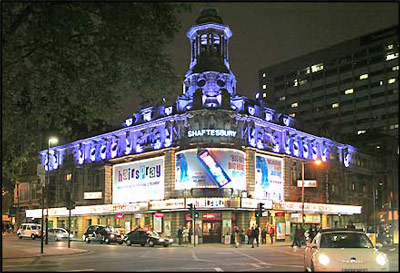
This Grade II listed building near Holborn is on the “Statutory List of Buildings of Special Architectural or Historic Interest”, thanks to a small roof collapse in 1973. At the time, the musical “Hair” was playing there, and it had reached its 1998th performance. The repairs forced the revolutionary hippy show to close, having been on since 1968. When “Hair” first came to the West End, it was blocked by the London stage-censor who was the wonderfully titled Baron Cameron Fromanteel “Kim” Cobbold. In order to get it staged, the producers appealed to Parliament, who simply passed a Bill removing Baron Cobbold’s powers. So the Shaftesbury Theatre effectively ended stage censorship in the UK. Not bad for a 1,400-seater theatre hidden behind New Oxford St!
9. Palace Theatre
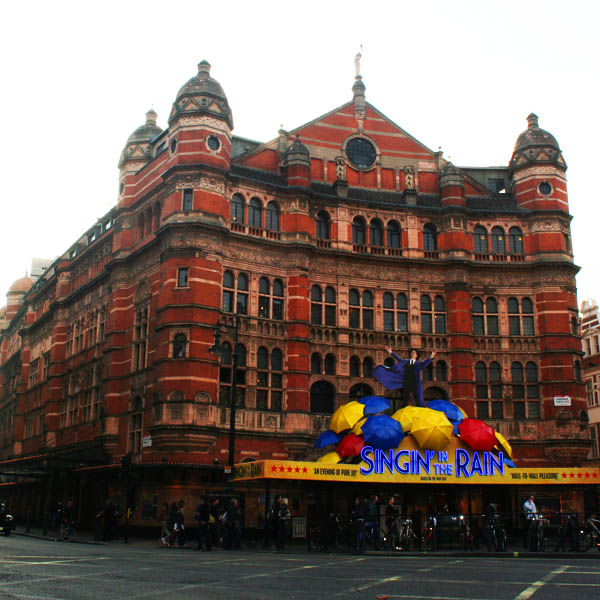
A few hundred meters down the road from the Shaftesbury Theatre is the Palace Theatre, another 1,400-seater that tends to stage huge musicals, like “Singing in the Rain” or “Spamalot“. It opened in 1891, and was called the Royal English Opera House, under the patronage of Richard D’Oyly Carte. Over the following years, it showed not just opera but music hall, films and variety shows. During the 1960s, “Sound of Music” ran there for 2,385 performances and it was a long term home to “Les Miserables”, from 1985 to 2004. A great theatre, which has seen some classic musicals. Like the Shaftesbury Theatre, it is a Grade II listed building and an unmistakeable London sight, taking up one whole side of Cambridge Circus.
8. Adelphi Theatre
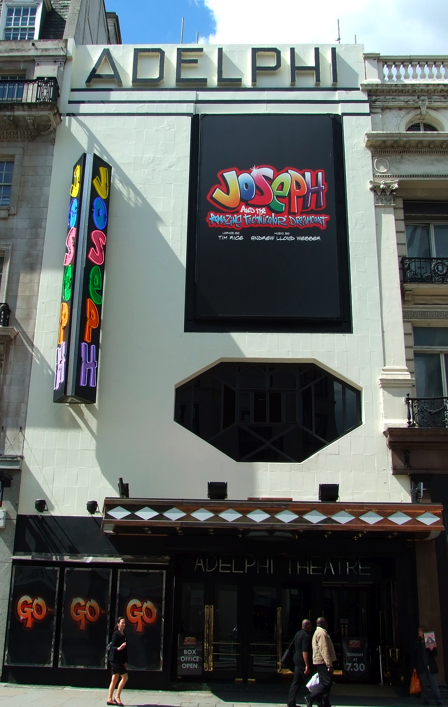
Next is the 200-year-old Adelphi Theatre, which looks deceptively narrow from its Strand entrance. It actually holds 1,500 people and has recently staged productions like “Joseph and the Amazing Technicolour Dreamcoat” and “Chicago”. It’s the fourth building to be on the site since its opening in 1809 and this version was built in 1930, its Art Deco style complementing the nearby Strand Palace Hotel. It’s also got its own ghost – the actor William Terriss, who was stabbed to death by his rival in 1897. A plaque on a neighbouring pub blames the death on a stage hand, but it was actually Richard Archer Prince, a frustrated actor who had been mentored by Terriss but had fallen out of favour thanks to his alcoholism and unpredictability. Prince pleaded guilty to criminal insanity and was sent to a mental institution, where he conducted the prison orchestra until his death. Presumably, Terriss wanders the corridors of the Adelphi frustrated at this mild sentence his killer and former protégée received.
7. Victoria Palace Theatre
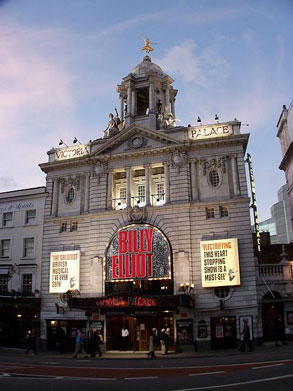
Some shows run for decades in the West End, so the current offering at the Victoria Palace Theatre – “Billy Elliott the Musical” is a relative newcomer. But still, it’s been on almost every night since 2005, which is a lifetime to some of its audience members! The theatre itself has had several lifetimes, since its first incarnation as a small concert room in 1832. The current 1517-seater theatre opened in 1911, complete with a sliding roof that was opened during the interval to cool the audience down. There have been many memorable shows at the Victoria Palace Theatre, but perhaps the most memorable was the 1934 “Young England“, which fell into the “so bad it’s good” category of theatre. Audiences memorised chunks of dialogue and hollered along with the actors, while laughing heartily. It was a runaway hit and lasted 278 performances.
6. Prince Edward Theatre

Found in the heart of Soho, this theatre holds 1618 people and was named after the future Edward VIII, the King who abdicated after just a few months, in pursuit of love. Similarly romantic stories have been played out on the stage there, such as “Show Boat”, “Mamma Mia” and “West Side Story”, and “Miss Saigon” is opening there next. It’s had a varied past since opening in 1930, with stints as a cinema and a dance hall before being restored to theatrical glory in 1978. “Evita” was the show that re-opened the theatre, with its world premiere being held there, and the tale of the Argentine President’s wife was a massive hit, running for over 3,000 performances and made a star of Elaine Paige, who played the title role.
5. Dominion Theatre
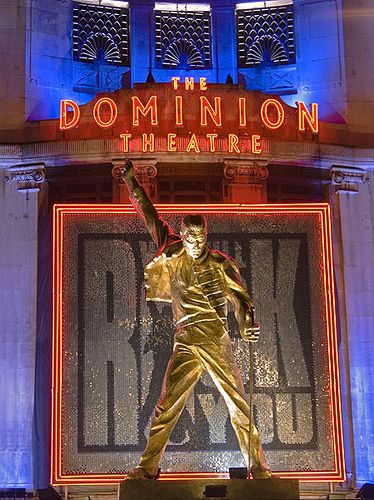
Amid the demolition of the Tottenham Court Road area of London to make way for a new transport link, one thing remains constant. And that’s the giant figure of Freddie Mercury, punching the air and inviting punters to come and see “We Will Rock You” at the Dominion Theatre. The show has been running there since 2002 and, despite bad reviews from critics, has been immensely popular. The theatre itself seats just over 2,000 people and was built in 1929, on the site of an old brewery that had once caused London to be flooded with beer. The Dominion is also home to the Australian mega-church of Hillsong, who meet there every Sunday and take full advantage of the stage lighting for their high-production-value worship services. Queen by night, God by day – who would have thought it would be such a comfortable mix?
4. Lyceum Theatre
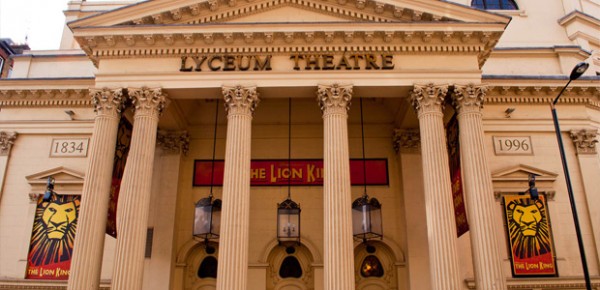
One of the grandest looking theatres in London, the Lyceum’s pillars come from its 1834 incarnation but the rest of the building was built in 1904 in the rococo style. There has been some kind of theatre on the site since 1765, even though it has had a variety of uses that have only been loosely connected to the theatre (for 50 years, the Sublime Society of Beef Steak met there to eat steak and drink port). It was also threatened with closure in 1939 but was saved after plans to build a road through it fell through. It has played host to “The Lion King” for the last 14 years and the Disney adaptation looks set to stay there for the foreseeable future, grossing £289m over its run.
3. Theatre Royal
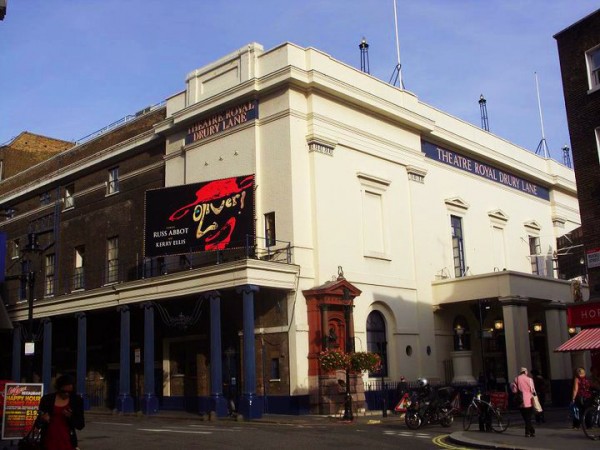
With a capacity of 2196, this was once London’s leading theatre. There have been several theatres on the site since 1663 and it’s Drury Lane location is the centre of “Theatreland”. As with many theatres in London, it is owned by Andrew Lloyd Webber, composer of musicals such as “Evita” and “Cats”. Among the many musicals staged at the theatre recently was “Oliver”, which was cast through the medium of a Lloyd-Webber fronted reality TV show. It has also showed “The Producers” and “Shrek” and is currently running £Charlie and the Chocolate Factory”.
It’s also meant to be the most haunted theatre in London, with ghosts including the Man in Grey, who sports a tricorne hat and was apparently killed in the theatre around the 18th or 19th century. Another ghost is Joseph Grimaldi, a clown, who is said to guide nervous actors around the stage when he appears. It’s good to have a helpful ghost or two!
2. London Palladium
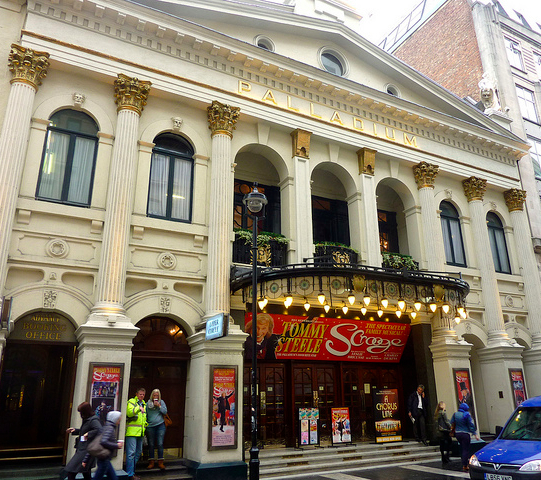
A name which is known around the world, the London Palladium is probably the most famous theatre in London, and one of the most famous in the world. A few moments’ walk away from the chaotic shops of Oxford Street, it made a name for itself by broadcasting “Sunday Night at the London Palladium” which showcased variety acts and ran from 1955 to 1967. Millions of viewers were familiar with the revolving stage and the hottest acts of the day, who performed. In 1966, the Palladium’s owner tried to sell it off for redevelopment, but it was saved by theatre-loving investors and carried on as both a theatre and a concert venue, with Slade performing there in 1973 (and nearly causing the balcony to collapse). It continues to thrive and is eagerly awaiting the start of 2014’s “X Factor:The Musical”
1. Apollo Victoria

It may not be the most famous London theatre, but it is the biggest, seating 2,500 people. Just metres away from the Victoria Palace Theatre, it forms a sort of mini-theatreland to the South West of the main West End. The theatre has some original Art Deco features, from its 1930 opening, with a nautical theme that includes shells and fountains built into the architecture. It was specially modified for 18 years to incorporate a track around the audience so that the cast of “Starlight Express” could skate through the auditorium. It is currently home to “Wicked” which shows signs of being every bit as popular as “Starlight” was. It shattered box office records in its opening week, by taking £761,000 and has so far lasted 7 years at the venue, grossing £150 million. Back at the birth of cinema, doom-mongers predicted that live theatre would die a rapid death. Statistics like these show that it’s unlikely to happen any time soon. Apparently, the smell of the greasepaint and the roar of the crowds still appeal to the masses…